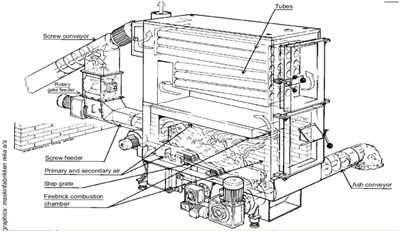Appliance types for households
For household use there are several options to use wood as fuel:
- open fireplace
- closed fireplace
- stove
- stove with back boiler
- boiler system.
Open fireplace
While it may be very cosy to sit around an open log fire, an open fireplace is an extremely inefficient and expensive way to use wood fuel to heat a room. The energy efficiency of an open fireplace is only around 25%, meaning that 75% of the heat goes up the chimney (see Figure 9). The heat that is obtained comes mostly from radiation, so you fry in the front and freeze in the rear.
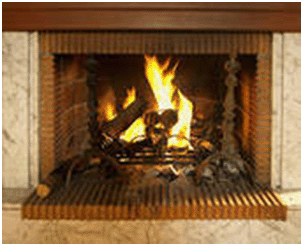
Figure 9 An open fireplace
Firewood or briquettes have to be carried into the room and may give off dust and fungal spores, especially if the firewood has been poorly dried.
Closed fireplace
A closed fireplace is a much better and cost effective way to use wood fuels for heating, and of course if it has a glass window, one can still see the flames (see Figure 10).
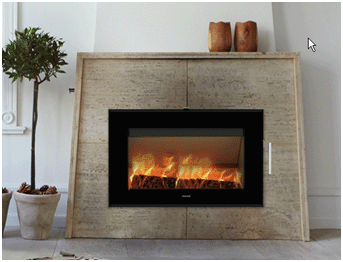
Figure 10 An Enclosed fireplace
These fireplaces may have an efficiency of up to 60-70%. The heat dissipation comes either from radiation or if the fireplace has a mantel, some heat comes from convection by air, which circulates though the space between the fireplace and the mantel. If the closed fireplace is built into a thick wall, then that wall can function as a heat store, which will release the warmth over a long period, even after the fire has gone out.
Fireplaces use either firewood or briquettes as a fuel. Fuels that consist of smaller particles like chips or pellets are not suited for these appliances. The fuel still has to be carried into the room and may leave dust and/or fungal spores.
Stoves
A stove is a free-standing unit in a room and is usually designed to heat only that room. Good stoves have an energy efficiency of up to 90% (see Figure 11).
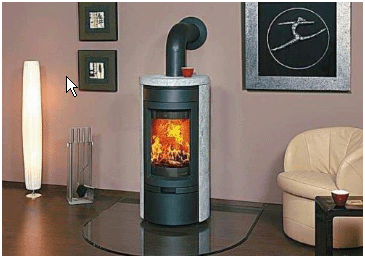
Figure 11 A free-standing wood stove
Sometimes the stove is equipped with a back burner, meaning that there is a heat exchanger built into the stove, through which water from the central heating system or hot water boiler is passing to be heated.
A kitchen stove can be used for cooking, and will keep the room warm at the same time. A disadvantage is that it can also heat-up the kitchen during summer.
Stoves can use a wide range of fuels, from firewood and briquettes to wood pellets or chips, but when buying a stove one needs to decide which fuel one wants to use, because some stoves handle only a limited range of fuels. Stoves that burn firewood or briquettes are batch loaded, while stoves that burn wood pellets or chips can have a small hopper with fuel attached to it and can run automatically on a thermostat.
Boilers
By definition a boiler is connected to a water-based central-heating system, run out to radiators in the building. In some modern houses there is under-floor heating and no or very few radiators. Boilers are usually placed in a boiler room separate from the rest of the house or even the rest of the building.
Boilers can handle all kinds of fuel depending on their make and model, but again it is not very likely that every boiler can handle every fuel, so again one should consider what fuel one wants to use. Some boilers which run fully automated on wood pellets or wood chips can also burn firewood or briquettes, but only with manual batch feeding. The fuel is usually stored in a hopper, which can contain enough fuel for several days or even weeks of operation. Sometimes the fuel hopper is situated in another room than the boiler, which reduces exposure to dust and fungal spores.
Nearly all of these appliances need a very dry or dry fuel, except for special boilers which can accept wet or very wet fuel ( Figure 12). These boilers have a ceramic lining that aids in the drying of the fuel, but usually they are of such a size that they are not suitable for domestic purposes.
Figure 12 Small step-grate boiler, suitable for wet fuel
Boilers can be divided in two main groups:
• Those that burn the fuel
• Those that gasify the fuel.
Burning boilers
These boilers normally have automatic feeding and use either wood pellets or wood chips as fuel. The fuel is fed on demand into the boiler by an auger. These boilers can be modulated to some extent, meaning that they do not have to run on full load all the time, but their output can be varied within certain limits. Modulation is governed by a room thermostat.
Any boiler will operate best when it is warm, because the drying of the fuel will be better. Every time a boiler has to be restarted from cold, extra emissions of unburned gasses and more dust will occur, therefore a wood burning boiler should be kept warm for most of the time. Boilers operate best at some 60% to 100 % of their rated output.
When properly maintained these boiler systems can run almost as automatically as oil or gas boilers. The only difference being that one every now and then has to remove the ash from the burning chamber and clean the heat exchange tubes.
The most luxurious models (and also the most expensive) have automatic start-stop, meaning that the boiler itself can restart the burning process by an ignition system.
Gasifying boilers
These boilers use a gasification process to convert the fuel from solid to gas. The fuel is batch loaded into the gasification chamber and consists either of firewood or briquettes (see Figure 13).
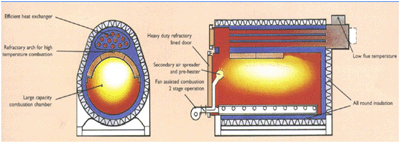
Figure 13 Gasifier working principle
The gasses are burned in a separate burning chamber. This conversion process can is difficult to modulate, so a large output can be expected until the batch of fuel has been used. The boiler can then be refuelled with a new batch or the fire can go out until the heat in the storage tank has been used. These domestic size gasifiers should be equipped with a water storage tank, so that the surplus heat can be stored in the water in the tank until it is needed. Needless to say such tanks should be well insulated. The size of the tank depends on the size of the boiler.
Combined heat and power
Very small combined heat and power systems exist which can provide heat and power to single households or small businesses, but they are still very expensive or in the development stage, so as such they cannot (yet) be recommended for general use.
Testing
For appliances up to 500 kW, an excellent European Standard exists for testing the systems. It is recommended to purchase only appliances that have passed this testing procedure. Ask for EN 303-5:2012 Heating boilers - Part 5: Heating boilers for solid fuels, manually and automatically stoked, nominal heat output of up to 500 kW - Terminology, requirements, testing and marking.
Appliance types for commercial or industrial applications
The larger appliances are meant for heating of large buildings, the supply of process heat or steam for industry, for district heating of large building complexes, villages or even towns or the co-production of heat and electricity for the aforementioned purposes.
For larger scale applications there are other options:
- stove
- boiler
- electricity production
- combined heat and power (CHP).
A stove could still be used in a single room like a workshop, but as soon as the building gets larger one should install a water-based heating system. The boiler can serve to generate heat only, or it can serve to produce heat for generation of electricity or a combination of electricity and heat, so-called combined heat and power (CHP).
Energy efficiency increases from stove to boiler to CHP, but if only electricity is produced from wood fuel, then the energy efficiency is almost the same as for an open fire in a living room, because the heat is cooled off, either in a cooling tower or to open water. In CHP, energy efficiencies of over 100% can be reached if the installation is equipped with a condenser on the flue gas system. The flue gasses are cooled by the returning water from the district heating system and while condensing, the energy that was used to evaporate the water is released and used to heat the return water by some degrees before it enters the boiler. The condensate is often used to wash” the flue gasses, resulting in very low particle emissions from these boiler systems. The condensate will have to be cleaned of particles that were washed out of the flue gasses before it can be released into the waste water system.
Combined Heat and Power is the best use of any fuel, but only if the utmost is done to utilise the heat that is generated as a “waste” product of the electricity generation. The electricity generation of most CHP installations is still based on the production of steam that is led through a steam turbine to power the electricity generator. The steam turbine and generator are expensive pieces of kit and the price of these units does not differ very much whether one generates 1 or 10 MWe but the cost per MWe is obviously much lower for the larger size units than for the small ones. This is then also the reason why the size of these CHP units usually is between 5 and 10 MWe. It should also be realised that for each MWe of electricity that is produced, one also generates 2.5 to 3 MWth of heat.
Combined Heat and Power has also been established by using a wood gasifier. The product gas is used in a gas turbine or in a piston engine, which in their turn drive the electricity generator. However the product gas must be of an exceptional good quality to be used in either of these appliances and must be free from tars and dust particles. If good gas quality can be obtained, smaller CHP installations would be possible than those based on steam generation. A lot of research and development work is on-going on these units.
A stove needs a dry fuel, but the other systems can either run on a very dry, dry or one of the wet fuels, again depending on how these appliances are built. It is more usual for the larger units to run on a wet fuel, because that is cheaper and more readily available.
Advice on how to choose the size of the appliance for domestic use
As stated before, biofuel boilers operate best when they are warm, that helps in drying the fuel and reduces emissions of any noxious substances and dust. Boilers should preferably run on 60 to 100% of their rated output.
This means that boilers should be chosen so that they cover the base load of a building, meaning the amount of heat that is needed to provide hot water and heat on a normal day. The peak load is when all the most adverse conditions occur at the same time: cold, wet and windy weather. Peak loads do not occur very often, and a rule of thumb says that a boiler that can cover 60% of the peak load can cover 92% of the annual load.
What to do when a peak load occurs and the boiler does not have enough capacity:
• Burn a drier fuel (when burning chips), this will give a higher output of the boiler
• Equip the system with a heat storage tank, that can take up heat in periods when there is no peak load and release it when one occurs
• Have a back-up system in the form of either the old boiler that was replaced by the biofuel boiler or an extra (small boiler) that will run on fossil fuel
• In larger buildings two boilers could be attached to the same fuel storage and handling system. One should be slightly larger than the second. The small boiler is used during summer; the big one will be used in spring and autumn, while both will operate during winter. This system allows the boilers always to be warm and operate on at least 60% of their rated capacity.
A very important message: do not size your biofuel boiler after the size of the gas or oil boiler it replaces. Usually these fossil fuel boilers are larger than needed, but since they can be easily modulated, that does not matter, but for biofuel boilers an oversize means that they do never get really hot, which has a bad influence on the level of emissions and the longevity of the appliance. More maintenance and repairs will be needed on an oversize biofuel boiler than one that is the right size.
An even more important message is to resist the inclination to add 10-30% output capacity when replacing a fossil fuel boiler in an attempt to ensure that there is enough “umpf” to heat a building. This will only result in the biofuel boiler being really oversized and it will almost certainly run badly most of the time.
Money will be well spent in having a reputable, independent heating engineer to advice on the right size of boiler. Collect as many fuel bills as possible from the old fossil fuel system to see how much heat is really needed in your circumstances. From these numbers the engineer should be able to calculate the appropriate size of the biofuel boiler.
For new homes, which are now better insulated than older build, one can use the degree day system to calculate the required boiler size, but that is something really for specialists.
As a rule of thumb: a house of 140 square metres (1500 square feet) would need a 12 kW boiler to keep the building comfortably warm all year round and to provide hot water.
Where to choose which kind of boiler and what fuel to use
In most cases it is the size of the fuel store which will determine which fuel to use, but also the capacity of the total system is important.
Small systems need a simple fuel to run smoothly, so here it should be either wood pellets or dry woodchip. Large systems use a lot of fuel and here it would be more economical to use wood chips instead of wood pellets.
In towns, space is usually restricted, while standalone houses in the countryside usually have much more room. We have seen in a previous chapter that wood pellets have a much higher energy density per tonne than wood chip or firewood, so this leads to the use of wood pellets in domestic situations in town.
In the country small systems can run on dry wood chips. One can produce dry wood chip by storing the required amount of roundwood off the ground and under cover in a sunny and windy place. Close to beginning of the heating season, the wood is chipped and the chips stored under roof in a well-ventilated space close to the boiler system.
As stated, large systems should preferably run on wet wood chip. It is easy to produce and is also cheap.
To produce dry wood chip, one has to harvest the wood as roundwood and store it under the right circumstances for a long period of time before it can be chipped. Harvesting roundwood is an expensive system and the cost of storage and covering has to be added to harvesting costs. On top of that the fuel will have to be stored under roof after chipping at the supplier, which also is a cost factor.
Table 2 recommends fuels for different locations and applications.
Table 2 Preferred fuel by location and boiler size

Table 2 Preferred fuel by location and boiler size (Large Image)

